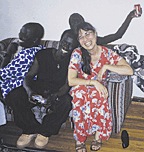
According to DiDinga lore, there lurk in the woods of Sudan nasty spirits called the Miningit. They have been known to grab and detain children for days, before releasing them with disoriented tales for their friends.
But when Syracuse University folklorist and play expert Dr. Faye McMahon G’89 Gr’92 asked some teenage DiDinga refugees living in the United States if a Miningit could be here, they laughed hysterically at her suggestion:
“There’s not a Miningit here!”
“You mean the Miningit can’t travel?” she asked.
“Oh the Miningit can travel.”
They went on to explain that while they are living in the United States, they don’t believe in the spirits. But when they eventually return to their home country—long battered by civil war—they expect to pick up those beliefs, along with other DiDinga customs, once again.
McMahon has been working with nine young DiDinga men, ages 15-22, since last August to help them find cultural outlets in the United States; in the process she is studying, among other things, the link between play and adaptability between cultures.
Having fled Sudan when war came to their villages in the early 1990s, many of the “Lost Boys,” as they were dubbed by the U.S. media, spent their early childhoods in refugee camps in Kenya; approximately 3,000 Sudanese from various ethnic groups were granted “safe haven” in the United States two years ago, and 80 boys were adopted by foster families in Syracuse.
McMahon came in contact with the DiDinga teens—the only members of this small ethnic group living in the United States —through a local refugee center while teaching a symposium on beauty at Syracuse, where she works as a research associate and a part-time instructor. She has been amazed at the DiDingas’ “phenomenal” ability to adapt to a culture so different from their own. In particular, she is interested in their traditional games, dances, and songs—many of them associated with the “age sets” they would have belonged to in Sudan—including the unique song, or ole, that each young man grows up singing to his pet bull in this cattle-reliant culture and a mocking tradition called the girikot, which they performed for her students last spring:
“They were singing in the DiDinga language: ‘Mary told me that she was pregnant, but she really isn’t. She’s just fat.’ I thought it was really typical of adolescent boys to choose that one.”
Demonstrating their adaptability, they came to McMahon’s class with aluminum pie tins, banging forks against them to replicate the sound of bells that traditionally would be tied around their ankles and wrists for the dance. For a more formal performance at a nearby arts center in July they had her search for ostrich feathers, chalk to grind down and paint their bodies with, and dried gourds from which to make whistles.
“I think the reason these young men are so quickly adaptable—we are talking about never having seen modern appliances before or things like snow—is because of the play phenomenon,” McMahon says. “Flexibility is a critical element in play. And without this adaptability, I think humans wouldn’t survive.”
She is working on a project through Syracuse’s Program on the Analysis and Resolution of Conflicts to put Sudanese refugees from both the DiDinga and Dinka ethnic groups in contact with other university students this school year.
A former art teacher and kindergarten teacher, McMahon has co-edited a book on children’s folklore, written entries for The Encyclopedia Britannica on children’s games, worked as a programming consultant for the Fox Television Children’s Network, and currently is editing a volume of scholarly papers on “communities at play.” Her husband, Dr. John McMahon G’90 Gr’93 is an associate professor of classics at Le Moyne College in Syracuse.
One subject Faye McMahon will be considering in her own research with the DiDingas is, “As some of these traditions are adapted to the U.S. and they perform some of the games and dances [here], and then go back [home], will there be any influence on their performances and traditions?”
As she studies that question, McMahon says, she must be careful to not influence which traditions they perform. “I don’t want to produce any cultural anachronisms,” she says. “I have to leave it up to them as they explore what they want to do.”
Recently, one of the refugees, Dominic Raimondo, located his brother from whom he had been separated during the war. Before he left on July 4 to join him in Salt Lake City, McMahon held a goodbye party where he sang his special bull song, and she asked him to write. “On July 5, my phone rang,” she says. “It was Dominic, and he was calling me to say he had arrived safely and that it was 105 degrees in Salt Lake City. He did not telephone his DiDinga friends or the caseworkers in Syracuse. As you can well imagine, it was a moving moment for me to be so honored by this young man. Across a thick cultural wall, we had connected.
“If it had not been for my major in folklore,” McMahon adds, “I probably would never have had this research interest in play and festival, and I would have never experienced this profound moment.”
—Susan Frith

